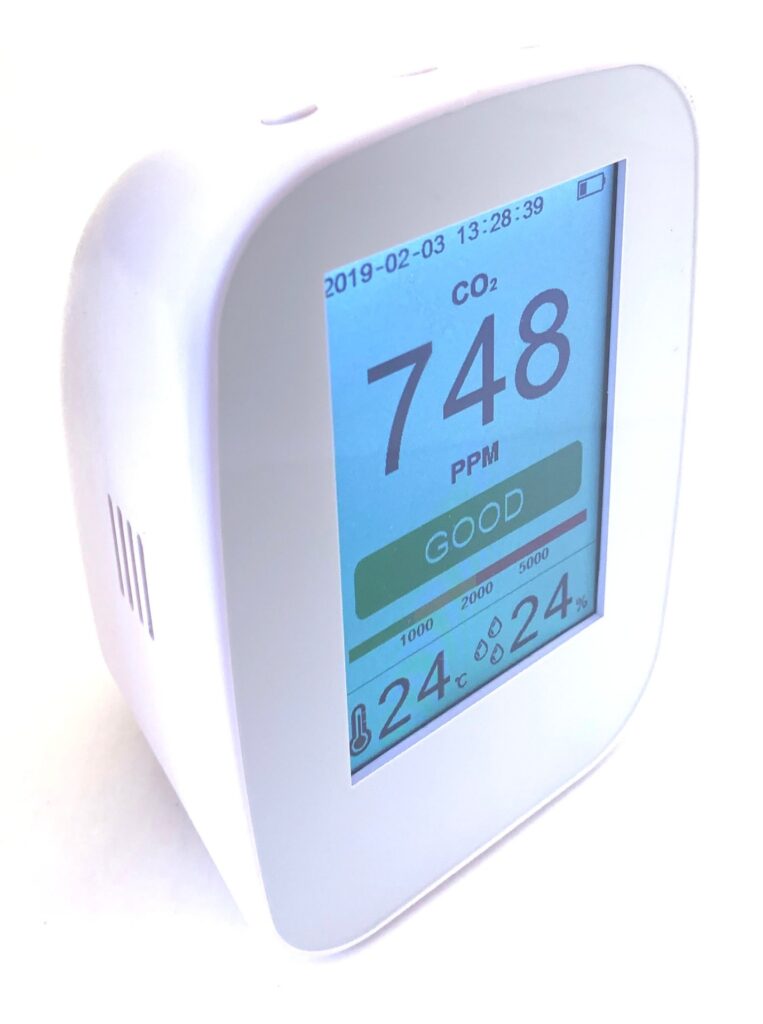This time OCRKJ D9-H. Which also can be found in some shops as unbranded LCD Digital Air Quality Monitor (AKA

Pros
- 3000 mAh battery ( 10 hours of battery life)
- additional sensors (HCHO, VOC
and PM2.5) - 16 different screens including trends
- Active airflow with the relatively quiet fan
- quality design and schematic inside (no glues, connectors, replaceable sensors)
- good CO2 sensor inside – SenseAir S8 LP
Cons
- slow charging – 8 hours (in operation mode)
- no connectivity (Bluetooth, wi-fi, USB mass storage)
- no ambient light sensor
- unconfigurable high CO2 limits (GOOD is up to 1000 ppm)
- wrong temperature and RH measurements (+3C, -10%RH)
It looks like relatively cheap SHT20 temperature and humidity sensor inside make it sort of a lottery if you will get correct measurements or not.
See device insides: https://wiki.liutyi.info/display/CO2/D9+Inside
SALE Price was: 102$

9 replies on “D9 Air Quality Detector”
Hello, I just discovered your excellent website. What is your opinion about this one: https://www.amazon.nl/gp/product/B088RD1KXV/ref=ppx_yo_dt_b_asin_title_o00_s00?ie=UTF8&psc=1
cannot say haven’t tested those. but it might be good idea to look on Aliexpress for chinese brands to get it cheaper (if your custom taxes makes that possible).
OKay, thanks a lot for your help. I ordered different types of CO2 testers and I am curious about the different values I will measure.
Usually All CO2 meters placed in same room and not moved week or two show more or less same CO2 values +/-10-20ppm (there is an autocalibration mechanism build-in in most of NDIR CO2 sensors). Different values issue starts in two cases
(1) you use one of the devices as portable and second is always stay at home. And that (using as portable) is better to do using device with some good CO2 sensor inside. Numbers may differ by 50-100 ppm in this case.
(2) eCO2 (estimated CO2 by TVOC sensor measurement) or some non-NDIR sensor, that is where values may be unpredictable (inacurate).
The problem I got with cheap devices is mostly wrong t/RH measurements not CO2 (for non portable case of use)
HI Liutyi amazing catalog of sensors, my compliment for your excellent engineering work/approach . Can you suggest something (site,link ,opinions) also for Outdoor sensors (airquality,temp, wind , solar radiation, snow level etc) thank you!
Does this unit comes with data storage function? So I can export the data into PC. Like record in 15 minutes interval.
Does it comes with data logger and can export the data into PC?
Hi,
I’ve managed to dump the firmware on the device; I’ve also patched it so it does not relock the microcontroller debug interface – https://drive.google.com/drive/folders/1hk7TVwiUXUIQMlAtf-SF8XyHcb_UPTzf?usp=sharing.
To flash it you’ll need to hold the right-most button (or connect the button pin to GND) and connect a SWD debugger to the J3 header (left-to-right: VREF-CLK-DATA-GND). Then, unlock (disable readback protection) using any tool designed for STM32 (GD32F103 is a clone of STM32F103).
I’m currently working on reverse-engineer the software to better understand the AQI rating and also connect it to a WiFi module – if you’re tehnically inclined in embedded SW, you could use IDAPro or Ghidra to do it as well, using the .bin file.
Hi.can U place firmware again? Please